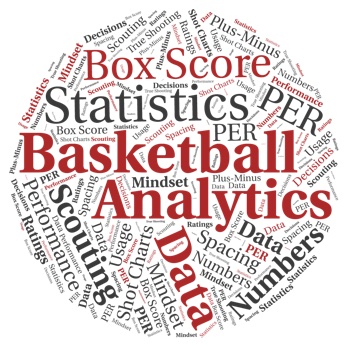People often confuse statistics and analytics as one concept that describes collection and interpretation of data. Although the fields are similar as they are working with data, the two sciences differ from one another. Statistics is the collection and interpretation of data, while analytics deals with finding patterns from the data. In basketball, both fields are very important for coaches as they can collect real time data of what is happening on the court, and analyze it after with other games to form certain conclusions. Moreover, players benefit from this analysis as they can see what areas of their game they need to work on.
Statistics Approach
Statistics, although very important in basketball, often don’t give a complete picture of what is going on on the court. Basic stats that have been kept for the last 70 years give crude numbers of what a players does during a game. Knowing which player is scoring the most points or grabbing huge number of rebounds is important, but those stats can sometime be misleading in how effective the player actually is. No matter how good the player is statistically, basketball is still a team sport so players need to be great in a team environment. Basic stats focus on an individual performance and even assists as a statistical category can be misleading. Players can hunt only those passes that result in assists and boost their stats that way.
Of basic statistical categories, shooting percentage is probably the most telling. It focuses on the efficiency of the player, which could be considered the most important stat in basketball. It shows how much the player is used and how successful he/she is in making shots in compared to missing them. However, even the shooting percentage isn’t a deep enough analysis as it doesn’t differentiate types of shots. In other words, statistics focus on the pure data without giving context of when and how it was collected.
Analytics Approach
Mark Twain once said that “there are three kinds of lies- lies, damned lies and statistics”. Although I’m not confident he was talking about basketball when he said it, we can use his philosophy to demonstrate the difference between statistics and analytics. What the American writer was suggesting is that statistics can be interpreted in numerous ways and the interpreter decides which approach to use. Statistics in basketball give the data about the player or the team, but it is up to the coaches to analyze it. Analytics make it much easier for them.
Some of the advanced statistics methods (as analytics is called as well) provide a clear picture for coaches on the trends that are happening on the court. In recent years we have seen a popularization of these advanced statistics such as effective field goal percentage or off/on court comparisons that represent a deeper analysis of the game. Coaches don’t only use these formulas to analyze their current players, but they have a huge role in recruiting and knowing what type of player you are bringing in. For example, a coach is trying to recruit a star high school player that is averaging 40 point per game, but his effective field goal percentage is bellow 50 percent and his assist percentage is very low. That could suggest that the player is very inefficient and that he doesn’t like sharing the ball with his teammates. The coach could be better off with a player that scores less points, but is more efficient and ready to make the right read.
Advanced stats also put much more emphasis on the defensive side of the floor. Traditional statistics consider only blocks and steals as defensive stats. A lot of elite defensive players make their presence felt without putting numbers in the box score, and analytics show how effective the player is when defending isolations or pick and rolls. Coaches can use this information to employ defensive schemes in order to maximize their personnel.
Analytics bring numbers to winning basketball. The advanced analysis show which players are instrumental for the team through certain categories, helping the coaches have a clearer picture of their abilities. One of your players might not be showing much in the traditional box score, but is moving the ball well and the team is winning when he/she is on the floor. Analytics make sure you don’t miss their contribution.






You don’t think Twain was a baller!?
Maybe he hooped with Naismith, you never know!